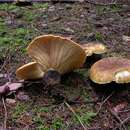mk
имиња во трошки


Netbladhat-familien (Paxillaceae) er en familie i Rørhat-ordenen. Netbladhatte har dog ikke rør, men lameller på undersiden af hatten.
Slægter
The Paxillaceae are a family of mushroom-forming fungi bearing close affinity to the boletes. Collectively, the family contains nine genera and 78 species.[2] The type genus is Paxillus, containing fungi with decurrent gills, and Gyrodon, which has members with decurrent pores, among others. French mycologist René Maire had erected the family in 1902, placing it between the agarics and boletes and recognizing the groups' similarities with the latter group.[3] Maire's usage of the name was later deemed to be invalid,[1] and the genus authority is attributed to Johannes Paulus Lotsy.[4] Molecular research confirms the relations of Gyrodon, with the decurrent-pored mushroom G. lividus, Paragyrodon, with the type species P. sphaerosporus, and Paxillus as sister groups, together lying near the base of a phylogenetic tree from which the genus Boletus arises.[5][6] The name Gyrodontaceae, published by Belgian botanist Paul Heinemann in 1951,[7] is considered synonymous with Paxillaceae.[1]
The Paxillaceae are a family of mushroom-forming fungi bearing close affinity to the boletes. Collectively, the family contains nine genera and 78 species. The type genus is Paxillus, containing fungi with decurrent gills, and Gyrodon, which has members with decurrent pores, among others. French mycologist René Maire had erected the family in 1902, placing it between the agarics and boletes and recognizing the groups' similarities with the latter group. Maire's usage of the name was later deemed to be invalid, and the genus authority is attributed to Johannes Paulus Lotsy. Molecular research confirms the relations of Gyrodon, with the decurrent-pored mushroom G. lividus, Paragyrodon, with the type species P. sphaerosporus, and Paxillus as sister groups, together lying near the base of a phylogenetic tree from which the genus Boletus arises. The name Gyrodontaceae, published by Belgian botanist Paul Heinemann in 1951, is considered synonymous with Paxillaceae.
Paxillaceae es una familia de hongos, de la superdivisión Dikarya, división Basidiomycota; tienen afinidad con Boletales.
La familia se compone de 9 géneros y 78 especies.[1][2]
Paxillaceae es una familia de hongos, de la superdivisión Dikarya, división Basidiomycota; tienen afinidad con Boletales.
La familia se compone de 9 géneros y 78 especies.
Les Paxillaceae (Paxillacées) ou Clade des Paxillinae sont une famille de champignons de l'ordre des boletales.
Les Paxillaceae, comme Paxillus involutus, contiennent un certain nombre d'espèces qui ont été impliquées dans des intoxications mortelles.
D'après la 10e édition du Dictionary of the Fungi[1] (2007), cette famille comprend les genres suivants :
Les Paxillaceae (Paxillacées) ou Clade des Paxillinae sont une famille de champignons de l'ordre des boletales.
Paxillaceae Lotsy, Vortr. bot. Stammesgesch. 1: 706 (1907).
Paxillaceae è una famiglia di funghi basidiomiceti appartenente all'ordine Boletales.
Il genere tipo è Paxillus Fr.
Paxillaceae Lotsy, Vortr. bot. Stammesgesch. 1: 706 (1907).
Paxillaceae è una famiglia di funghi basidiomiceti appartenente all'ordine Boletales.
Meškutiniai (lot. Paxillaceae) – baravykiečių (Boletales) eilės grybų šeima.
Išaugina vidutinio dydžio mėsingus vaisiakūnius. Himenoforas lakštelinis. Lakšteliai šakoti, palyginti siauri, nuo šviesiai geltonos iki oranžiškai rudos spalvos.
Auga ant žemės, rečiau ant medienos.
Lietuvoje žinomos gentys:
Paxillaceae is een botanische naam, voor een familie van schimmels. Volgens de Index Fungorum [9 maart 2009] bestaat de familie uit de volgende 25 geslachten: Alpova, Anastomaria, Argylium, Austrogaster, Bullardia, Campbellia, Gilbertiella, Gilbertina, Gyrodon, Hoehnelogaster, Hydnomerulius, Hyperrhiza, Meiorganum, Melanogaster, Paragyrodon, Parapaxillus, Paxillopsis, Paxillus, Pseudogyrodon, Rhymovis, Rodwaya, Ruthea, Sarcopaxillus, Uloporus en Uperhiza.
Paxillaceae is een botanische naam, voor een familie van schimmels. Volgens de Index Fungorum [9 maart 2009] bestaat de familie uit de volgende 25 geslachten: Alpova, Anastomaria, Argylium, Austrogaster, Bullardia, Campbellia, Gilbertiella, Gilbertina, Gyrodon, Hoehnelogaster, Hydnomerulius, Hyperrhiza, Meiorganum, Melanogaster, Paragyrodon, Parapaxillus, Paxillopsis, Paxillus, Pseudogyrodon, Rhymovis, Rodwaya, Ruthea, Sarcopaxillus, Uloporus en Uperhiza.
Krowiakowate (Paxillaceae Lotsy) – rodzina grzybów z rzędu borowikowców (Boletales)[2].
Grzyby częściowo mikoryzowe, wytwarzające kapeluszowe owocniki naziemne, czasem nadrzewne z hymenoforem blaszkowym. Blaszki hymenoforu są wąskie, zbiegające i często, szczególnie przy trzonie, połączone są anastomozami, o zabarwieniu żółtym, pomarańczowym lub brązowym. Zarodniki krowiakowatych są gładkie lub brodawkowane, a ich wysyp barwy od jasnokremowej do brązowej[3].
Rodzina Paxillaceae jest zaliczana według "Catalogue of Life: 2009 Annual Checklist" do rzędu Boletales i należą do niej rodzaje[2]:
Klasyfikacja przedstawiona przez "Systema Naturae 2000" umieszcza rodzinę krowiakowatych również w rzędzie borowikowców. Zalicza się do niej rodzaje[4]: zębiak (lejkoporek, Gyrodon), lisówka (Hygrophoropsis), Neopaxillus, krowiak (Paxillus);
Krowiakowate (Paxillaceae Lotsy) – rodzina grzybów z rzędu borowikowców (Boletales).
Alpova
Austrogaster
Gyrodon (jelšar)
Hydnomerulius
Meiorganum
Melanogaster
Paragyrodon
Paxillus (podvihanka)
Podvihanke (znanstveno ime Paxillaceae) so družina gliv iz reda cevarji. Družina vsebuje 9 rodov in 78 vrst.[1]
Podvihanke (znanstveno ime Paxillaceae) so družina gliv iz reda cevarji. Družina vsebuje 9 rodov in 78 vrst.
Плодові тіла великі м'ясисті, що складаються з шапинки та ніжки. Гіменофор пластинчатий. Пластинки легко відділяються від м'якоті шапинки, розгалужені, низько спускаються на ніжку, інколи з'єднуючись виразними перегородками. Гіменофор відкритий, несправжні покривала відстуні, поверхня шапинки суха темно-жовтого або коричневого кольору. Провідний рід Свинуха (Paxillus). Представники роду неїстівні або отруйні.
Відповідно до «Словника грибів» (2007) (Dictionary of the Fungi) родина включає роди:
Ростуть в лісах на ґрунті та деревині.
Свину́шковые (лат. Paxillaceae) — семейство грибов порядка болетовых.
Семейство впервые описано французским микологом Рене Мэром в 1902 г., но впоследствии опубликованный Мэром таксон был признан недействительным (nom. inval.), валидной в настоящее время является публикация нидерландского учёного Й. Лотси (1907 г.) На основании признаков гименофора семейство считалось «промежуточным» между болетовыми и агариковыми грибами, а затем было отнесено к порядку болетовых. Принадлежность его к болетовым подтвердилась только после появления метода молекулярно-филогенетического анализа, но в самом этом семействе, представленном немногочисленными родами, произошли значительные изменения.
Роды Paxillus и Gyrodon положены в основу клады, в которой содержатся представители рода Boletus[1].
网褶菌科(學名:Paxillaceae),又稱樁菇科,是担子菌门牛肝菌目的一個科,有別於典型牛肝菌目物種,本科物種具有蕈褶。网褶菌科最早於1902年由法國真菌學家René Maire(英语:René Maire)命名,認為本科介於傘菌與牛肝菌之間,但其命名不被認定為有效名稱(英语:Validly published name)[1],1907年定義本科的荷蘭植物學家Johannes Paulus Lotsy(英语:Johannes Paulus Lotsy)才被認為是本科的命名者[2]。截至2008年,本科包含9個屬,共78個物種[3]。本科物種的子實體為肉質,有些物種具有蕈柄,有些則無,蕈褶常有分叉,且易與蕈傘分離[4]。分子證據顯示牛肝菌目中,网褶菌科與牛肝菌科為姊妹群[5]。
网褶菌科(學名:Paxillaceae),又稱樁菇科,是担子菌门牛肝菌目的一個科,有別於典型牛肝菌目物種,本科物種具有蕈褶。网褶菌科最早於1902年由法國真菌學家René Maire(英语:René Maire)命名,認為本科介於傘菌與牛肝菌之間,但其命名不被認定為有效名稱(英语:Validly published name),1907年定義本科的荷蘭植物學家Johannes Paulus Lotsy(英语:Johannes Paulus Lotsy)才被認為是本科的命名者。截至2008年,本科包含9個屬,共78個物種。本科物種的子實體為肉質,有些物種具有蕈柄,有些則無,蕈褶常有分叉,且易與蕈傘分離。分子證據顯示牛肝菌目中,网褶菌科與牛肝菌科為姊妹群。